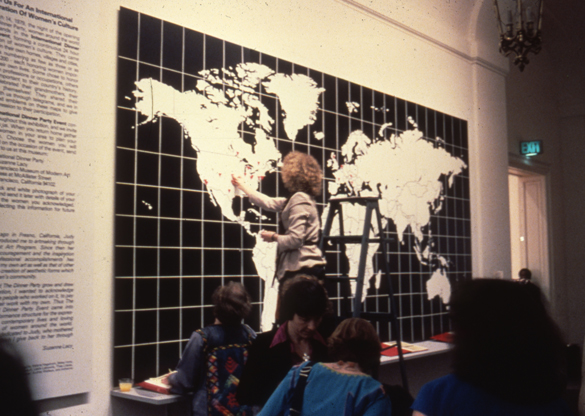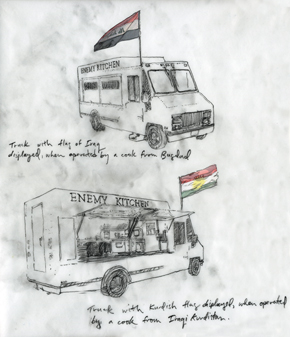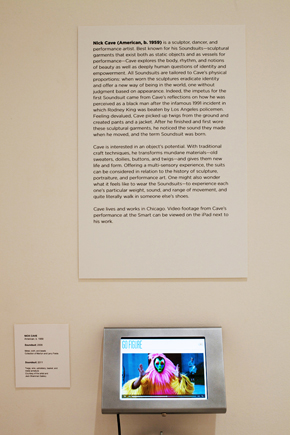Kelley Heider: September 2011 Archives

Feast artist Suzanne Lacy is known for engaging in projects that challenge traditional lines of division between artist and audience as well as traditional notions of artistic production and display. Lacy's lesser-known, The International Dinner Party (1979), is a perfect example of such a project. In The International Dinner Party performance, Lacy united feminist culture workers around the globe by inviting them to stage dinners that paid tribute to a particular woman in each group. By focusing on the convivial gathering as a site of strengthening personal bonds, Lacy exploded the locality and individual ownership of her creation--engaging about 2,000 women through 200 dinners that took place across Africa, Asia, Europe and North and South America during a 24-hour period. Lacy believes that projects like The International Dinner Party have the potential to transform rigid notions of art and artist because they encourage "a more subtle and challenging criticism in which assumptions--both those of the critic and those of the artists--are examined and grounded within the worlds of both art and social discourse."
Read more about The International Dinner Party and the legacy of Suzanne Lacy in Stephanie Smith's essay, "Mapping the Terrain, Again," which appeared in the Summer 2011 issue of Afterall.
Image: Documentation of Suzanne Lacy's The International Dinner Party performance, San Francisco Museum of Modern Art, 1979.

American artist, Michael Rakowitz recently shared with us a sketch of the Enemy Kitchen food truck he plans to create this winter for Feast. In the Enemy Kitchen project, Rakowitz uses his Iraqi-Jewish heritage as a point of departure for exploring food's potential to foster meaningful exchange across cultural difference.
Current plans for the food truck project involve inviting chefs from Chicago's Iraqi community to collaborate with Rakowitz on a menu, with members of the local chapter of Iraq Veterans Against the War participating as servers.
Check back for regular updates on the development and launch of the Enemy Kitchen food truck.
Image: Michael Rakowitz's working sketch for the Enemy Kitchen food truck, a commission for Feast. Courtesy of the artist.
Current plans for the food truck project involve inviting chefs from Chicago's Iraqi community to collaborate with Rakowitz on a menu, with members of the local chapter of Iraq Veterans Against the War participating as servers.
Check back for regular updates on the development and launch of the Enemy Kitchen food truck.
Image: Michael Rakowitz's working sketch for the Enemy Kitchen food truck, a commission for Feast. Courtesy of the artist.
 By Diego Arispe-Bazan
By Diego Arispe-BazanMA'11 University of Chicago and Smart curatorial intern
As high-tech tools become more accessible and essential in every day life, rhapsodized about by tech-savvy urbanites and digital age apologists, the debate over their relevance has become a hot topic among museum administrators, curators, and programmers. A large component of my job as a curatorial intern at the Smart this summer involved evaluating visitor engagement with the artist videos that accompanied the Go Figure exhibition, so as to inform the development of interpretive media for Feast.
The Education Department was planning to conduct surveys regarding visitor perspectives on the exhibition, so I asked them to include a few questions about the videos, which showcased artists discussing the particulars of their work in short, conversational interviews. But I also decided to work undercover. In addition to the quantitative data docents could collect via survey, I added a qualitative, observational research component. I spent time in the gallery each day. I took notes in my own handy gadget (an old, Generation 1 iPod), recording the demeanor, body language, and trajectory of visitors within the gallery. I listened, and occasionally elicited statements regarding the videos as if I were merely an inquisitive visitor. While varying from individual to individual, general gestural and verbal cues are similar across the board. I also enlisted the aid of the gallery attendants after several of them, upon hearing about my project, enthusiastically volunteered their own observations of visitor movement through the gallery.
The debate on interpretive technologies was lively among the Smart interns. It centered on the issue of how multiplicity in experience could be flattened out. The argument is not without basis: interpretive technology, used indiscriminately, can turn a gallery into an arcade. In fact, certain visitors who shared this view eschewed the iPads entirely. However, through my observation and the comments gathered from the museum guards, it became clear that those who chose to pick up the iPads were eager to embrace the integration of interactive digital media into the gallery experience. The only negative comment was that the volume was sometimes too loud.
Ultimately, as innovative curators and researchers such as Nina Simon and Dana Carlisle Kletchka have explained, the inclusion of interactive media in the museum should not be viewed as an impending inevitability, but an opportunity to connect with visitors and enthusiasts. Far from oppressively didactic, the videos in Go Figure offered visitors an expanded understanding of the process behind the composition of each piece, and some of the theoretical entanglements that inspired them. Since many of the pieces to be included in the Feast exhibition are performative, or showcase objects employed in past performances--whether they are instruments or detritus--the interpretive media to be included should definitely continue in this vein. Because our goal is to enrich individual engagement with artists and their work, these enhancements seem to make sense.
Photo by Joseph Rynkiewicz
photos by Kristine Moss
By Jenn Sichel
University of Chicago PhD student and Smart curatorial intern
Ana Prvacki's Recipe for Slatko:
Required: Strawberry 1 kg, 1.5 kg of sugar
Preparation: Strawberries are carefully cleaned of leaves and handles, washed and squeezed, arranged in a dish and drizzled with lemon juice. Leave strawberries in the juice for at least two hours so they tighten and not fall apart during cooking. After they sit in the lemon juice arrange the strawberries in the cooking pot*, layer a layer of strawberries then a layer of sugar, then a layer of strawberries until no ingredients are left. Cover with cloth and leave over night. The next day add to the pot half a cup of water, put it on a high flame and cook watching to make sure it does not burn. The slatko will cook for 10 minutes and all the smell will stay in the strawberries. Take off the flame, remove the foam, cover with a wet cloth and leave to cool for a few hours.
*IMPORTANT: the slatko should be cooked in a cast iron pot, and nothing else should have been cooked in it before so the sugar does not burn. When we made it for the Hammer I ended up buying a new Le Creuset pot that I now use for regular cooking.
This recipe yields about three jars of mouth-vibratingly sweet slatko. Make your own batch and let us know how it turns out!
By Jenn Sichel
University of Chicago PhD student and Smart curatorial intern
During a normal day at the museum, we all work diligently behind computer monitors and occasionally go to meetings in conference rooms. During a not-so-normal day at the museum, we might all drop what we're doing to help with a big installation. But one Friday in August, we all dropped what we were doing to head to the community kitchen at the Experimental Station to make and can 60 jars (well, 59 after I dropped one) of a traditional sweet strawberry jam called "slatko." And by sweet, I mean VERY sweet--1 1/2 kilograms of sugar for every 1 kilogram of strawberries! All of us chopped, cooked, and sealed jars together--interns, registrars, event planners, educators, curators, and even one mother-of-the-curator--it was a real family affair. The slatko we produced will be used for the Greeting Committee, an interactive, site-specific installation by Feast artist Ana Prvacki. Come February, you'll all be able to sample the sweet fruits of our labor. Literally.
Last week Ana explained to us the very personal roots of her installation that brings a new hospitality ritual to the often sterile museum environment:
I grew up with a possibly semi fictional story about multicultural manners and misunderstanding. My Romanian mother married my Serbian father and moved to Yugoslavia in 1975. There was a lot of curiosity about her arrival, family and neighbors were all dying to meet her, a young foreigner from the land of gypsies, vampires and Ceausescu, what could be more fun over coffee! Apparently they knew she was pretty but also possibly a thief, or at least very hungry and wild. And when she finally arrives she is tiny, does not speak a word of Serbian and is understandably confused by her welcoming committee standing expectantly in the doorway. Someone is holding a tray to her. She has not been informed that it contains a jar of jam like substance called "slatko", literally translated as "sweet", and it is indeed sweet, a kind of honey jam with sugar that makes the roof of your mouth vibrate. Next to it is a glass with teaspoons and a few glasses of water, the protocol being to have a spoon (or less) of the jam followed by a glass of water and then enter the household, with sweetness and welcome in ones mouth. My mother, unfamiliar with the custom and eager to make a good impression proceeds to consume the entire jar, one spoon after the other, with mmmmm's trying to sound and look delighted like any good guest should. Half way though the jar her hosts are in awe, amazed, worried, nodding to each other, she really must be hungry, they have it hard in Romania, what good sweet we make...It is unclear what happened next and I wonder if anyone tried to stop her, or if they brought out another jar. I will ask her, but I doubt she remembers clearly in her sweet delirium.
Enjoy the pictures of our adventures in slatko-making. More to follow, including a recipe!
Stephanie Smith and students of the Food for Thought course convene at the home of professor Laura Letinsky for a meal of grilled octopus, flatbread and souffle. Letinsky later discusses with students the ways in which practices of hospitality allow her to explore new themes in her art. These photos were taken by Stacee Kalmanovsky, Food for Thought TA, during last spring quarter ('11).